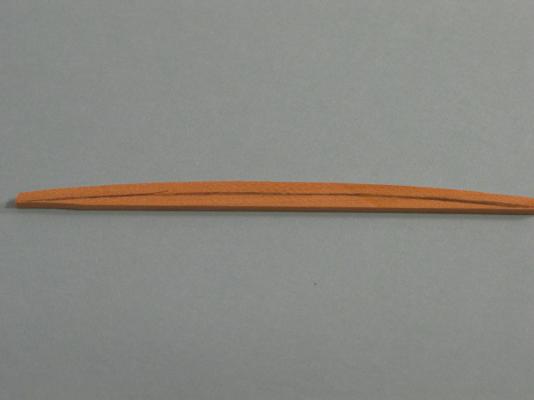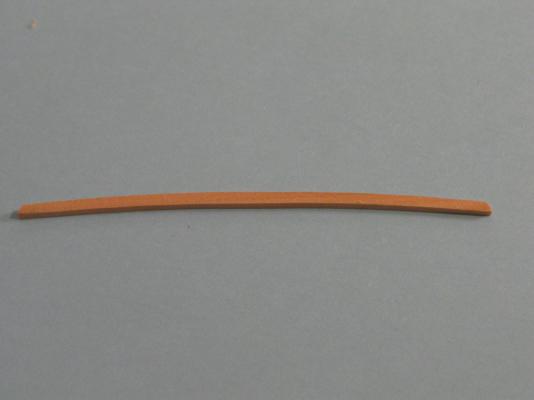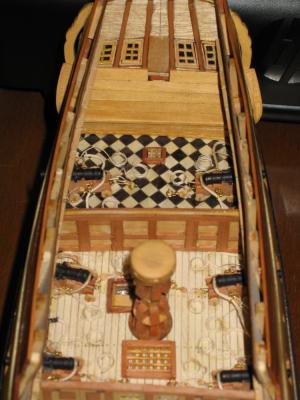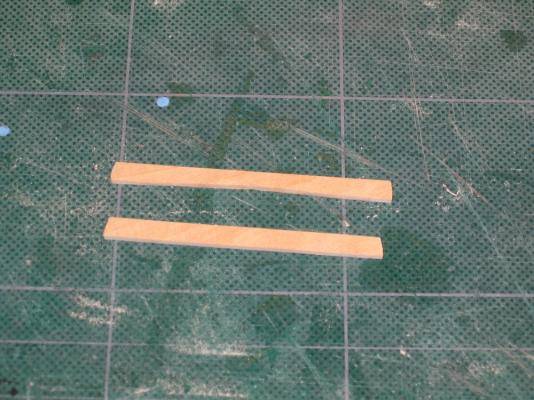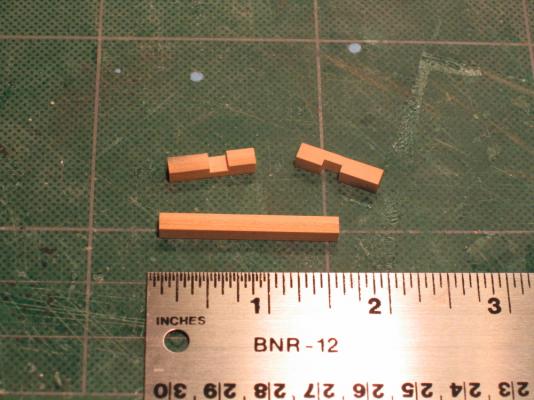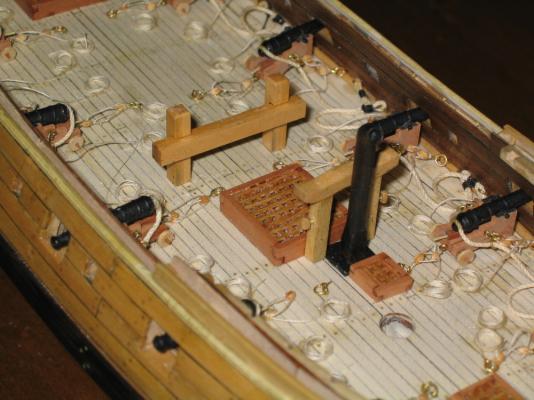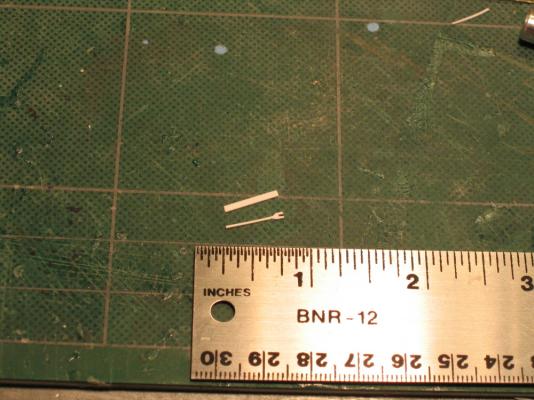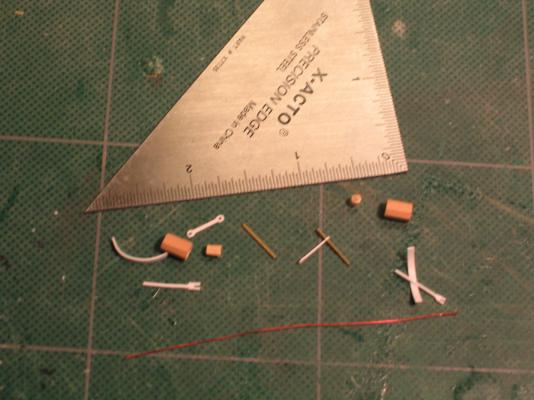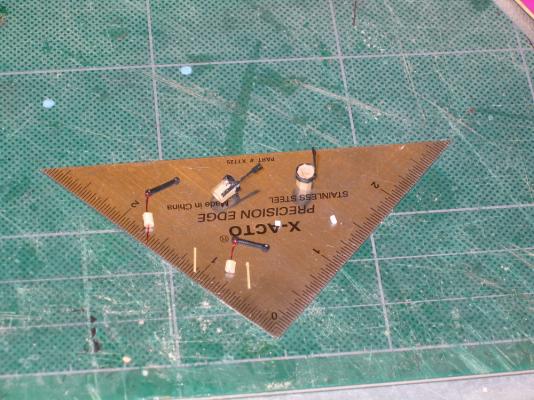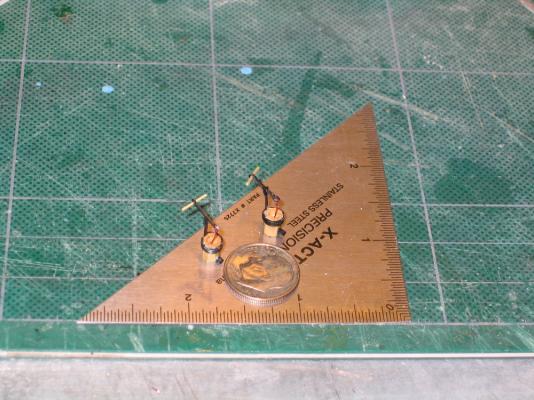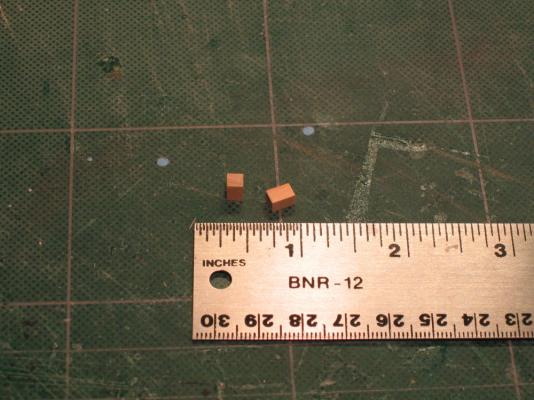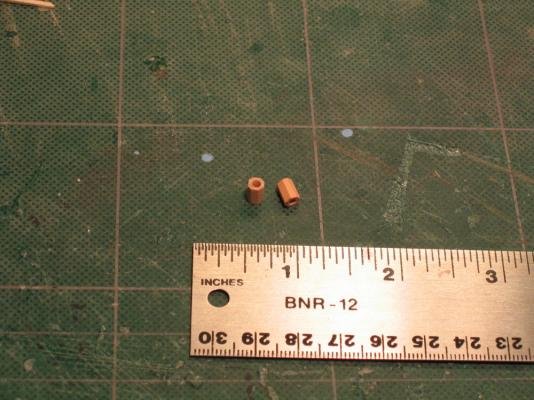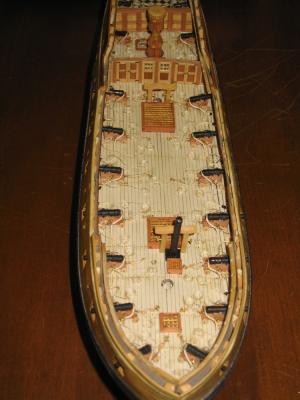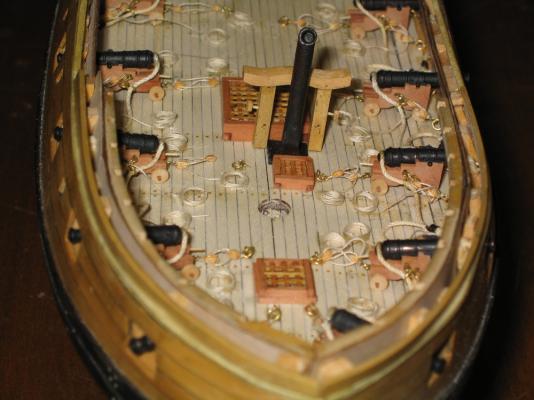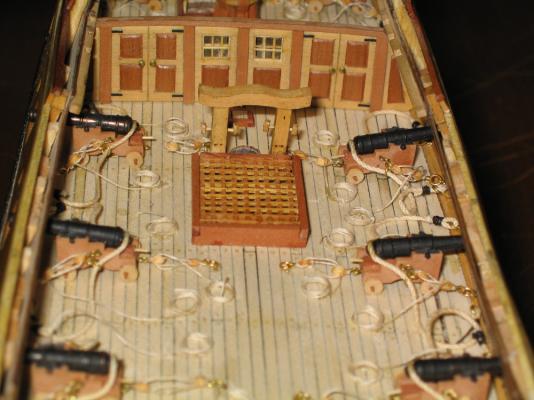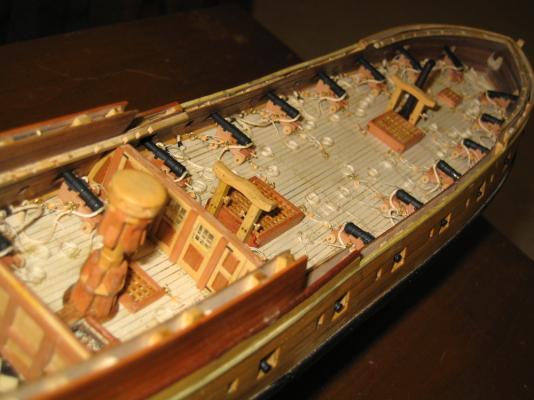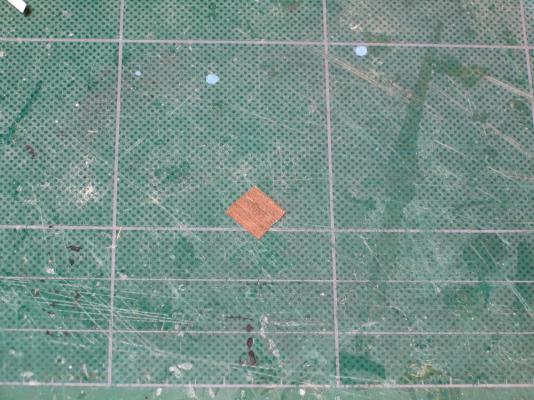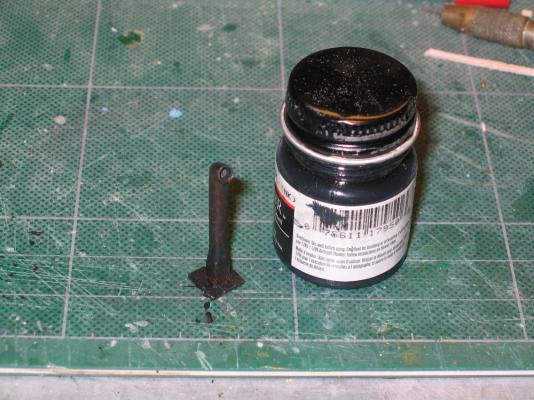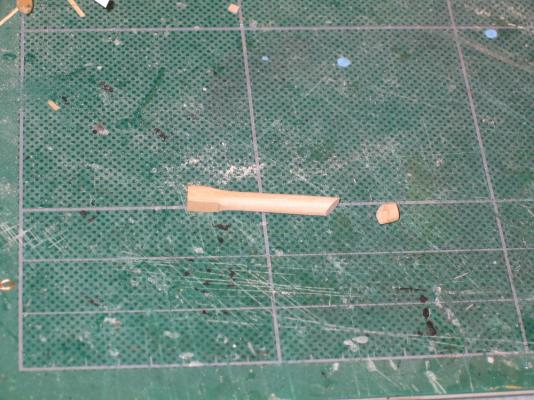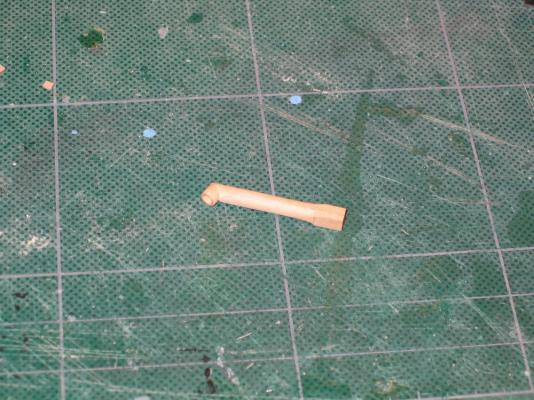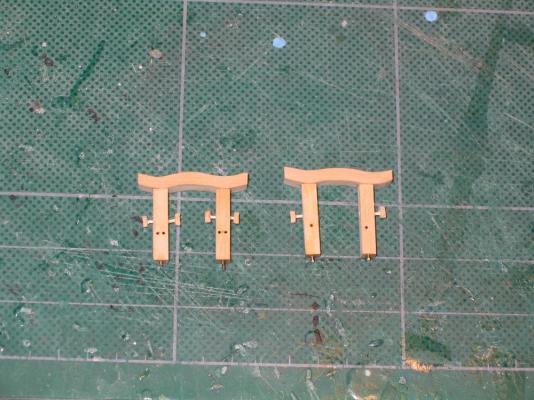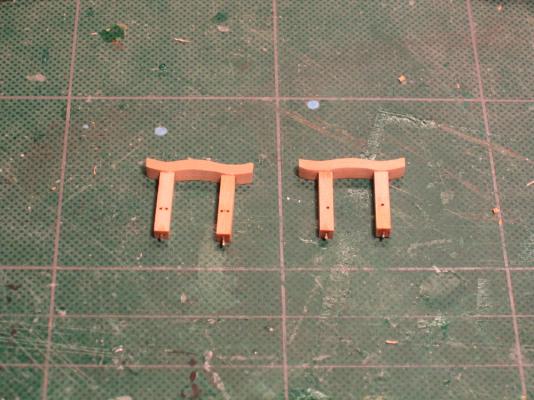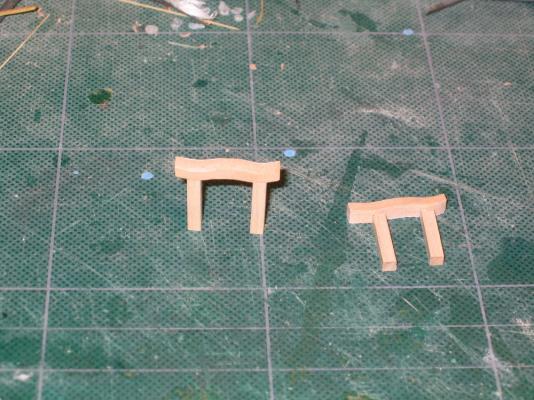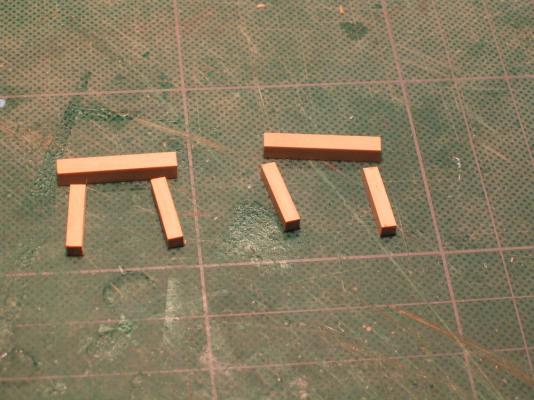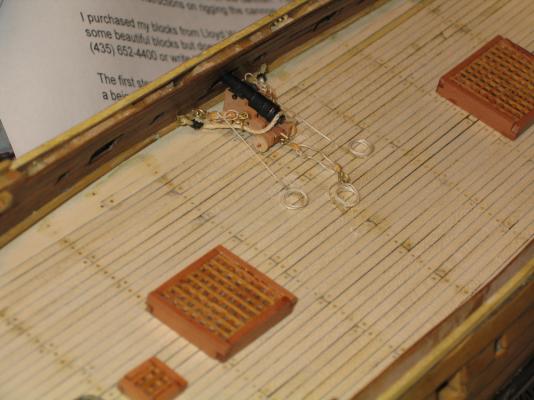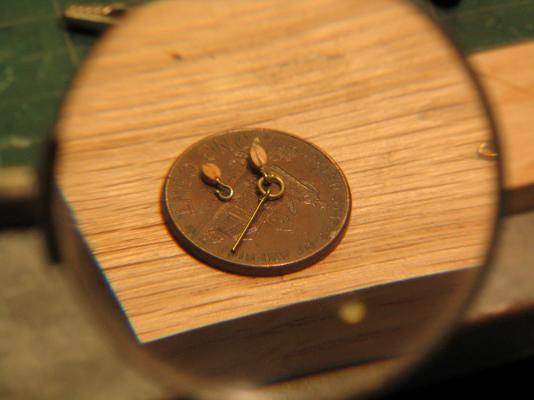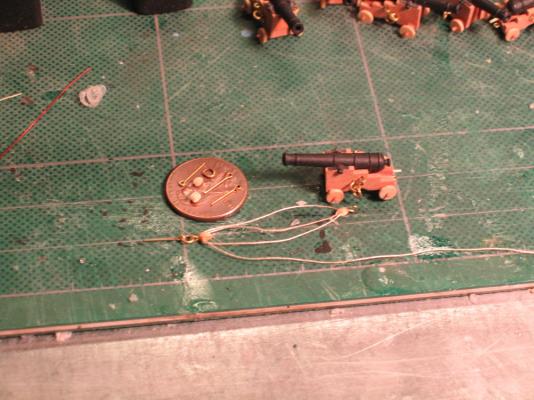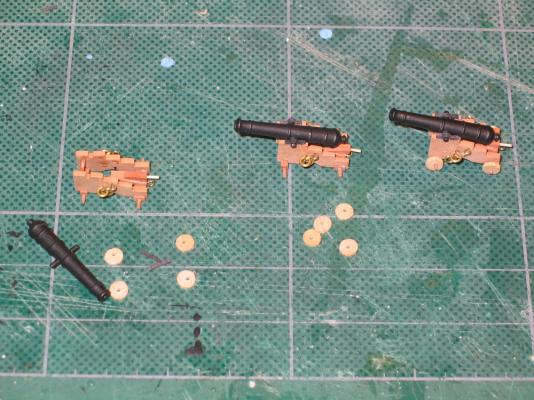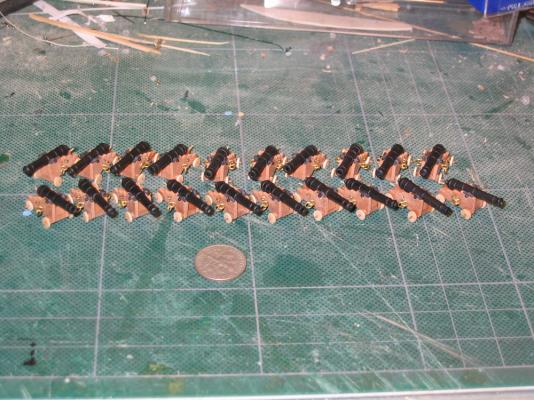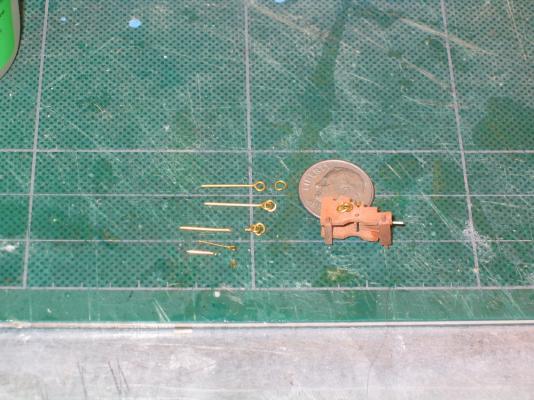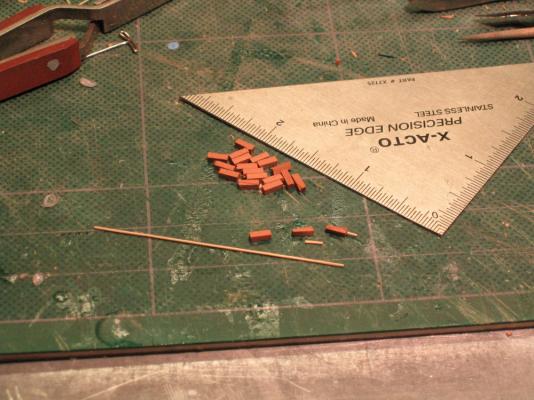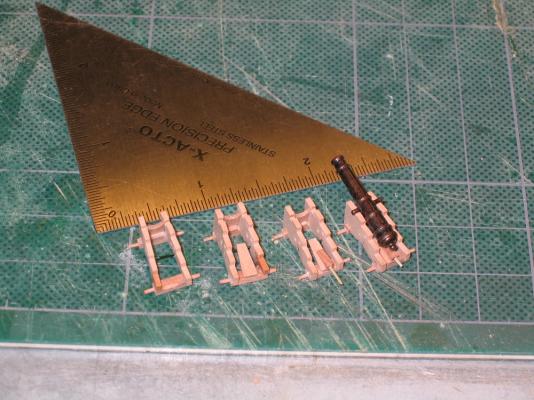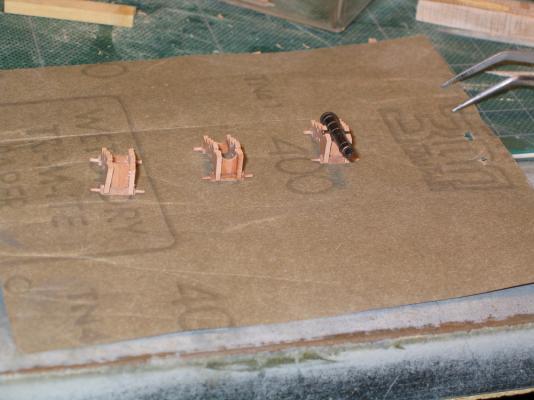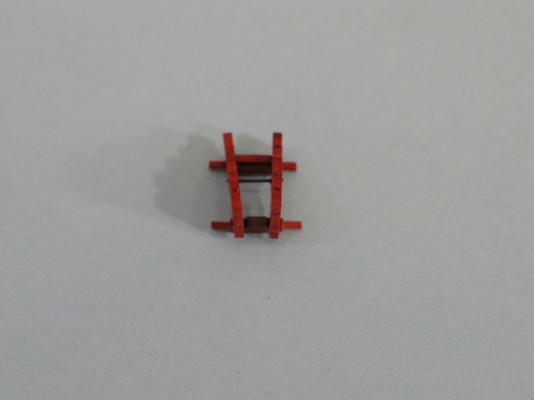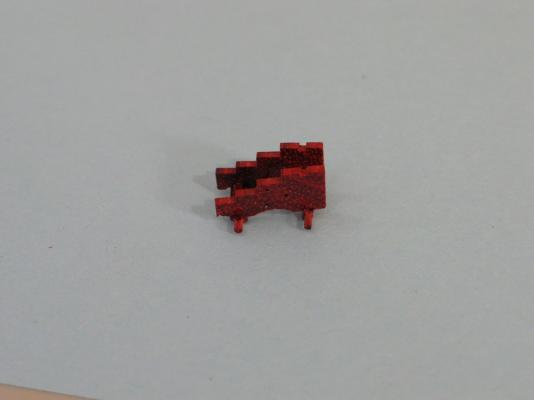-
Posts
2,603 -
Joined
-
Last visited
Content Type
Profiles
Forums
Gallery
Events
Everything posted by JSGerson
-
CHAPTER 8 - QUARTERDECK & FORECASTLE Quarterdeck – Problems, Problems, Problems The quarterdeck is constructed using 15 unique and custom made deck beams. That is, each and every one has a different length and camber from the previous one. Each one must be custom fit by trial and error as direct measurements are all but impossible. The basic stock is 1/16” x 5/32” boxwood. The end thickness of the beam is 1/16” and the center of the beam it thickens to 5/64”. Mr. Hunt stated that he freehanded the line for the camber. He may have calibrated eyeballs, but I used a French curve. The following images from the Practicum show the process.
- 974 replies
-
- rattlesnake
- mamoli
-
(and 1 more)
Tagged with:
-
The Practicum then directs the builder to install the seat using short forward pointing slats. I thought that would be very uncomfortable to sit on so elected to use side to side planks like Mr. Hahn’s model. I also added a molding where the base meets the parquet floor. It was here that I noticed that Mr. Hunt either missed it or chose not to install the scupper in the Captains quarters. I added that as well. End Chapter 7
- 974 replies
-
- rattlesnake
- mamoli
-
(and 1 more)
Tagged with:
-
The Practicum wanted the vertical pieces to end 1/16” below the side window. Mine ended at the window in order for the bench seat to be horizontal and not pitch. Here is how it looked installed. Sorry for the blurry image.
- 974 replies
-
- rattlesnake
- mamoli
-
(and 1 more)
Tagged with:
-
The Bench in the Captains Quarters The Practicum now directs us to the Captains Quarters to create the bench on top of the lower counter surrounding the rudder shaft hole. The vertical base section is made from two horizontal pieces of 1/16” x 3/16” boxwood which must be custom fit through trial and error. Due to the error I talked about that I made at the very beginning in Chapter 1, the dimensions in this area did not match what was shown on the plans. So I had to wing it. The bottom piece had to account for the camber in the deck, the waterways, and the inward slanting bulwarks.
- 974 replies
-
- rattlesnake
- mamoli
-
(and 1 more)
Tagged with:
-
- 974 replies
-
- rattlesnake
- mamoli
-
(and 1 more)
Tagged with:
-
The hardware that goes on the pumps is made from very thin styrene plastic painted black. Normally I would have chosen black paper for scale, but because the vertical post that holds the pump rocker arm is a real supporting member, paper wouldn’t work. The band that goes around top is .10” x .04” styrene. The post is made of .015” x .06” styrene and it has a U-shape notch at the top to support the rocker arm. The pump shaft is wire which fits into a hole in the rocker arm. Because the pump cylinder was completely hollowed out, a plug was fashion out of some scrap wood and hole was drilled into it for the pump shaft to fit. This was fitted into the bottom of the octagon cylinder. The spouts are made 3/64” rod styrene plastic. The last item was the rocker arm handles. The Practicum called for this to be fabricated out of wire painted black. I choose to make it look like wood and used bamboo again made using a draw plate. Once everything was painted and assembled, it was installed on the model.
- 974 replies
-
- rattlesnake
- mamoli
-
(and 1 more)
Tagged with:
-
The Elm Tree Pumps Here is another little fun project, the two elm tree pumps. Two pieces of Boxwood 5/32” x 5/32” are cut to 7/16” lengths. Then instead of making a round cylinder out of them, they are carved into octagonal cylinders. The next step was the hollow out just the top part but I found it easier to hollow out the whole thing. I started by drilling a small hole and enlarging it with bigger and bigger bits, then with a round needle file.
- 974 replies
-
- rattlesnake
- mamoli
-
(and 1 more)
Tagged with:
-
Once the paint dried, it was installed onto the model. This how the model looks with the gallows bits and galley stack installed.
- 974 replies
-
- rattlesnake
- mamoli
-
(and 1 more)
Tagged with:
-
At this point the Practicum instructs the builder to use Magic Marker to color the stack black and install it onto the model. Having looked at other models, I chose to add a baseplate figuring that the actual ship would have some sort of shield to protect the deck from the hot stack. I used three pieces of walnut planking from the kit and glued it to a base plate. The stack was glued to the baseplate and everything was painted black. Then I assumed that on the actual ship they would have used iron plate to make the stack and because iron and sea water don’t like each other, I added some rust stains.
- 974 replies
-
- rattlesnake
- mamoli
-
(and 1 more)
Tagged with:
-
Galley Stack The galley stack is fairly simple. The main piece is a vertical 5/32” x 5/32” boxwood 1¼” long that was carved into a cylinder ¼” from the square bottom and angled at the top. A second piece cut 5/32” long also carved into a cylinder, angled at one end, and hollowed out. The two angled ends were glued together to form an elbow.
- 974 replies
-
- rattlesnake
- mamoli
-
(and 1 more)
Tagged with:
-
The final touch was to add cleats to the posts. Mr. Hunt spent half a page discussing where they should be placed. The kit showed they were fore and aft on the posts while Mr. Hahn’s showed them inside and outside for the first gallows bit and just the outside for the second. Mr. Hunt finally concluded to follow Mr. Hahn’s approach after checking numerous references. Let me tell you, those cleats are tough to carve due to their shape and size.
- 974 replies
-
- rattlesnake
- mamoli
-
(and 1 more)
Tagged with:
-
Before the posts were finally glued to the top two hole were drilled for wire studs to secure the top on and to secure it to the deck. In addition two holes were also drilled into the side of the posts to represent sheaves in the first gallows bit and one hole per post for the second one. At this point I hope
- 974 replies
-
- rattlesnake
- mamoli
-
(and 1 more)
Tagged with:
-
Cutting an image of the profile of the top to the horizontal piece and rubber cementing it on provided the template from which to shape it.
- 974 replies
-
- rattlesnake
- mamoli
-
(and 1 more)
Tagged with:
-
Gallows Bits With the cannon installation behind me, the two gallows bits were a pleasant change - simple. It amounted to cutting two 1/8” x 1/8” pieces for the posts and one 1/8” x ¼” for the top horizontal piece.
- 974 replies
-
- rattlesnake
- mamoli
-
(and 1 more)
Tagged with:
-
- 974 replies
-
- rattlesnake
- mamoli
-
(and 1 more)
Tagged with:
-
The recoil rope was made from kite string I had in the house. The eyebolt that went into the deck was a bit larger with a ring. The recoil rope went through the ring and was seized with black thread. The rope was made to look like it draped over the back of the cannon by applying some glue. I originally wanted to loop the rope around the back, but had too much difficulty due to the stiffness of the string. . The rope coils were made after the end of the tackle was glue to the deck. They were wrapped around a thin dowel, slipped off with a touch of glued and then eventually glued on top of rope ends on the deck. In subsequent gun installations, I moved the coils closer to the guns. One down, 19 more to go!
- 974 replies
-
- rattlesnake
- mamoli
-
(and 1 more)
Tagged with:
-
The block with hooks, which the Practicum (at least at this stage did not address) first had a hole drilled on the opposite end where the tackle rope headed. A small eyebolt was opened up enough to create a hook and then cut off at the stem. It was then inserted into the drill hole in the block with a touch of super glue. This time thread was twisted around the protruding stem of the hook and wrapped around the block, and twisted once again with a touch of glue. The excess stub of short thread was cut off leaving the remaining long end of the thread as the rope.
- 974 replies
-
- rattlesnake
- mamoli
-
(and 1 more)
Tagged with:
-
I also noticed that many of the blocks had hooks. Because the kit’s blocks looked a bit crude and oversized not to mention the kit did not address gun rigging at all, I knew that I would need a whole bunch more blocks both single and double. Using blocks purchased from Lloyd Warner, Warner Woods Inc. as suggested by the Practicum, I set about the task of creating the necessary block configuration. Because the holes of these blocks as so small, ordinary beige thread was used as rope. The simple blocks were wrapped with thread and the ends twisted with a touch of super glue as shown in the Practicum.
- 974 replies
-
- rattlesnake
- mamoli
-
(and 1 more)
Tagged with:
-
Rigging the Cannons I may have gone a bit overboard on the cannon rigging. The Practicum simplified the rigging by rigging only the recoil rope for all but two cannons and those were rigged with the tackle that only pulled the cannon to the gunport. I chose to do the whole thing: the recoil rope, the two tackles the draw the cannon to the gunport and the tackle that pulls the cannon away…for all twenty cannons. Here is a typical diagram I found during my research.
- 974 replies
-
- rattlesnake
- mamoli
-
(and 1 more)
Tagged with:
-
Barrels and Cap Squares The last item in the construction of the cannon assembly is the installation of the cannon and cap squares. As Mr. Hunt discovered, the cap squares supplied with the kit are out of scale. A simple strip of black paper will suffice. The pictures below show the progression.
- 974 replies
-
- rattlesnake
- mamoli
-
(and 1 more)
Tagged with:
-
Eyebolts After studying numerous pictures of cannons, I noticed that the eyebolts were not the same size. The eyebolt used for the recoil rope was larger than the eyebolt used to haul the carriage back and forth. I bought a bunch of smaller eyebolts. See earlier caution in Side Holes discussion. The eyebolts stems are cut to fit into the side holes. The recoil eyebolt has a rope ring through it. I added one additional eyebolt at the back of the carriage which the Practicum did not discuss. It is used to haul the cannon carriage away from the gun port.
- 974 replies
-
- rattlesnake
- mamoli
-
(and 1 more)
Tagged with:
-
The quoin The quoin is a wedge with a handle used to raise and lower the cannon for aiming. The twenty 3/16” quoins are made from 1/16” x 1/16” stock and trimmed to shape. The Practicum instructs the builder to make the handle from wire and insert it into a drilled hole in the wedge. From pictures of actual quoins I’ve seen, the handles appear to be made from wood. So instead of the wire, I used bamboo drawn through the drawn plate, just like I made the treenails. The picture below shows the progression.
- 974 replies
-
- rattlesnake
- mamoli
-
(and 1 more)
Tagged with:
-
The transom The transom is the front piece of the carriage. Twenty 7/32” pieces were sliced from 1/32” x 5/32” stock. After they were installed into the front of the carriage, a U-shaped surface is filed into it. This is where the cannon barrel will rest. The picture below shows the progression.
- 974 replies
-
- rattlesnake
- mamoli
-
(and 1 more)
Tagged with:
-
The stool bed The bottom of the cannon carriage is called the stool bed. It is trapezoidal in shape with a groove cut into it to rest on the wire that was installed through the carriage walls. Twenty pieces were sliced off from 1/32” x 1/8” swiss pear stock. CAUTION: The Practicum stated the pieces should be 3/16” in length. I found they should be 5/16”. The tablesaw was used to cut the groove. The pieces were then trimmed to the specified trapezoidal shape and installed into each carriage.
- 974 replies
-
- rattlesnake
- mamoli
-
(and 1 more)
Tagged with:
-
Initial Assembly The initial assembly consists of the two axles being attached in the notches cut in the bottom of the carriages. The front of the carriage is slightly narrower than the back. A small piece of wire is inserted in the smaller bottom hole and is super glued on each side. As I didn’t take pictures at this stage, the following photos are from the Practicum.
- 974 replies
-
- rattlesnake
- mamoli
-
(and 1 more)
Tagged with:
About us
Modelshipworld - Advancing Ship Modeling through Research
SSL Secured
Your security is important for us so this Website is SSL-Secured
NRG Mailing Address
Nautical Research Guild
237 South Lincoln Street
Westmont IL, 60559-1917
Model Ship World ® and the MSW logo are Registered Trademarks, and belong to the Nautical Research Guild (United States Patent and Trademark Office: No. 6,929,264 & No. 6,929,274, registered Dec. 20, 2022)
Helpful Links
About the NRG
If you enjoy building ship models that are historically accurate as well as beautiful, then The Nautical Research Guild (NRG) is just right for you.
The Guild is a non-profit educational organization whose mission is to “Advance Ship Modeling Through Research”. We provide support to our members in their efforts to raise the quality of their model ships.
The Nautical Research Guild has published our world-renowned quarterly magazine, The Nautical Research Journal, since 1955. The pages of the Journal are full of articles by accomplished ship modelers who show you how they create those exquisite details on their models, and by maritime historians who show you the correct details to build. The Journal is available in both print and digital editions. Go to the NRG web site (www.thenrg.org) to download a complimentary digital copy of the Journal. The NRG also publishes plan sets, books and compilations of back issues of the Journal and the former Ships in Scale and Model Ship Builder magazines.




